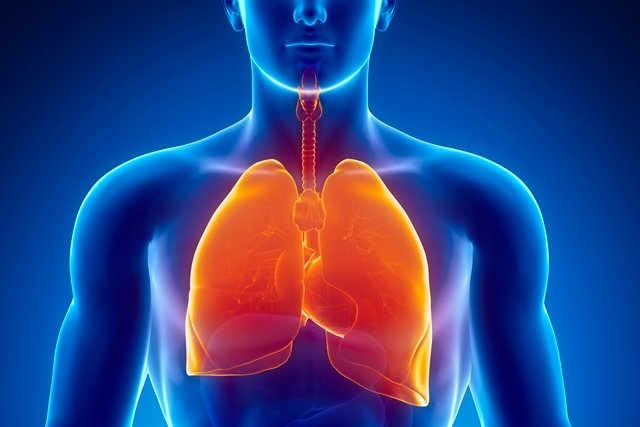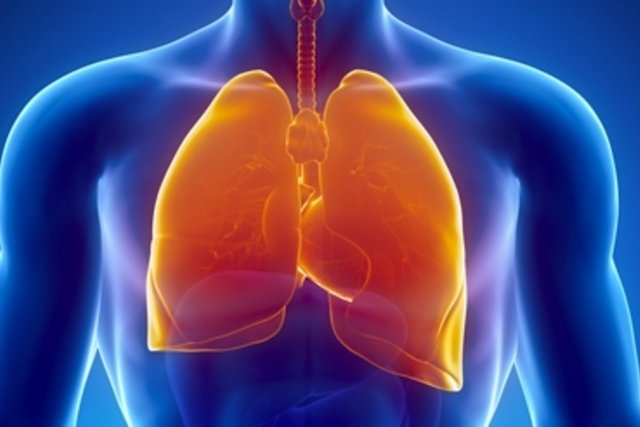Pulmonary thrombosis, also known as pulmonary thromboembolism, occurs when a clot (thrombus) blocks a vessel in the lung, preventing the passage of blood and causing the progressive death of the affected part, resulting in symptoms such as pain when breathing and intense shortness of breath.
Due to difficulty breathing and lung damage, the amount of oxygen in the blood decreases and organs throughout the body can be affected, especially when there are several clots or when thrombosis lasts for a long time, causing massive embolism or pulmonary infarction. .
Therefore, pulmonary thromboembolism is a serious condition that, whenever suspected, must be evaluated and treated as quickly as possible in the hospital with medication directly into the vein, oxygen and, in some cases, surgery.

Main symptoms
The main symptoms of pulmonary thrombosis are:
- Intense shortness of breath, which can appear suddenly and worsen over time;
- Intense chest pain;
- Rapid breathing;
- Coughing up blood;
- Bluish skin, especially on the fingers and lips;
- Palpitations;
- Feeling of fainting.
The intensity of symptoms may vary depending on the size of the clot and the duration of the thrombosis. Whenever there is shortness of breath, intense chest pain or coughing up blood, it is always very important to go to the hospital to identify the cause and start treatment, as these are symptoms that are generally associated with more serious problems. Check out a more complete list of all symptoms.
Make an appointment with your nearest doctor to evaluate your symptoms and check your risk of thrombosis:
Taking care of your health has never been easier!
Causes of pulmonary thrombosis
Pulmonary thrombosis is usually caused by a blood clot, or thrombus, that travels from another part of the body to the lung, becoming stuck and preventing blood from flowing to part of the lung. Some factors that increase the risk of having clots and developing this problem include:
- History of deep vein thrombosis;
- Family history of pulmonary thrombosis;
- Leg or hip fractures;
- Coagulation problems;
- History of heart attack or stroke;
- Obesity and sedentary lifestyle.
Pulmonary thromboembolism can also be caused by other rarer causes, such as air bubbles, in the case of pneumothorax, or in the presence of fragments capable of obstructing a blood vessel, such as fat droplets, for example.
Does COVID-19 increase the risk of thrombosis?
According to the results of several studies carried out, COVID-19 infection appears to increase the risk of clot formation which, consequently, can cause the appearance of serious complications such as pulmonary thrombosis or venous thrombosis. This type of complication appears to be more common in people hospitalized with severe COVID-19 infection.
In order to reduce the risk of thrombosis, the Brazilian Society of Thrombosis and Hemostasis (1) recommends prophylaxis with anticoagulants in patients hospitalized with COVID-19, as well as regular blood tests to evaluate parameters that appear to be directly related to the risk of clots, such as the quantification of D-dimer. See what D-dimer is and what its relationship is with the appearance of clots.
How the treatment is carried out
The treatment of pulmonary thrombosis must be carried out in the hospital with injectable anticoagulant medications, such as Heparin, to dissolve the clot and allow blood to flow again. In more serious cases, medications called thrombolytics can be used, which are extremely effective in quickly dissolving thrombi.
The doctor may also prescribe painkillers, such as Paracetamol or Tramadol, to relieve chest pain and facilitate breathing, and it is generally necessary to use an oxygen mask to aid breathing and blood oxygenation.
Normally, it is necessary to stay hospitalized for at least 3 days, but in more serious cases of thromboembolism, or in which it is not possible to use medication to dissolve the clot, it may even be necessary to undergo surgery to remove this thrombus, called embolectomy. , and, therefore, hospitalization may last longer.
Is there a cure for pulmonary thrombosis?
Pulmonary thrombosis, despite being a medical emergency, when treated correctly and quickly has a good chance of being cured and does not always leave consequences. The most common consequence of this situation is a decrease in oxygen in a certain region, which can lead to the death of these tissues and problems in the affected organ.
Possible sequels
Most of the time, pulmonary embolism is treated promptly and, therefore, there are no serious consequences. However, if the treatment is not carried out correctly or if there is a very large area of lung affected, very serious consequences such as heart failure or cardiac arrest can occur, which can be life-threatening.
Bibliography
- BMJ. Covid-19 and thrombosis: what do we know about the risks and treatment?. 2020. Available at: <https://www.bmj.com/content/369/bmj.m2058>. Accessed on May 20, 2021
- ORSI, Fernanda Andrade et al.. Guidance on diagnosis, prevention and treatment of thromboembolic complications in COVID-19: a position paper of the Brazilian Society of Thrombosis and Hemostasis and the Thrombosis and Hemostasis Committee of the Brazilian Association of Hematology, Hemo. Hematology, Transfusion and Cell Therapy. Vol.42, n.4. 300-308, 2020
- RAJA, AS et al.. Evaluation of Patients With Suspected Acute Pulmonary Embolism: Best Practice Advice From the Clinical Guidelines Committee of the American College of Physicians. Annals of Internal Medicine. Vol.163, n.9. 701-711, 2015
- NHS. Pulmonary embolism. Available at: <https://www.nhs.uk/conditions/pulmonary-embolism/>. Accessed on April 27, 2020
- NATIONAL HEART, LUNG AND BLOOD INSTITUTE. Venous Thromboembolism. Available at: <https://www.nhlbi.nih.gov/health-topics/venous-thromboembolism>. Accessed on April 27, 2020
- MERCK MANUAL PROFESSIONAL VERSION. Pulmonary Embolism (PE). Disponível em: <https://www.merckmanuals.com/professional/pulmonary-disorders/pulmonary-embolism-pe/pulmonary-embolism-pe?query=Pulmonary%20Embolism%20>. Acesso em 27 abr 2020

Sign up for our newsletter and stay up to date with exclusive news
that can transform your routine!
Warning: Undefined array key "title" in /home/storelat/public_html/wp-content/plugins/link-whisper-premium/templates/frontend/related-posts.php on line 12
Warning: Undefined array key "title_tag" in /home/storelat/public_html/wp-content/plugins/link-whisper-premium/templates/frontend/related-posts.php on line 13





